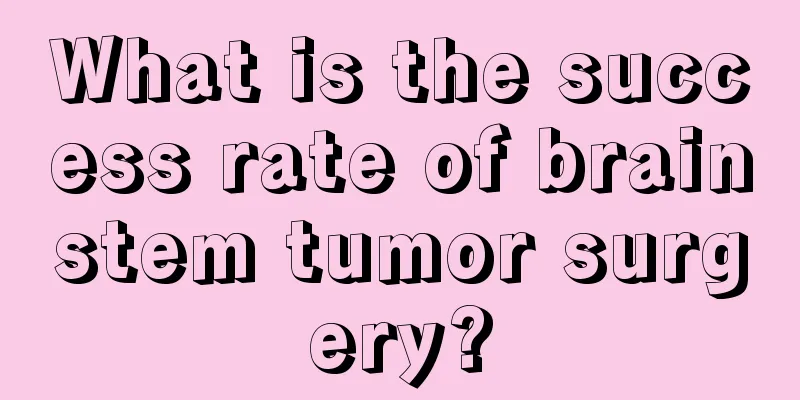What is the success rate of brainstem tumor surgery?

|
Brainstem tumors are a type of cerebral hemangioma caused by human glial cells. They can easily spread in the brain and are generally more common in middle-aged and elderly people. They are likely to develop in the fourth part of the brain. Brainstem tumor surgery is a relatively common treatment method. Generally, the success rate of brainstem tumor surgery is low and it can also be life-threatening, so it needs to be performed with caution. Is surgery for brainstem tumors successful? The main treatment for brainstem tumors is radiotherapy. Surgery is very risky, with high mortality and disability rates, and is generally not recommended. The more mature treatment method is radiotherapy, including Gamma Knife and CyberKnife. Please choose surgery carefully and consult an authoritative neurosurgeon. Traditional Chinese medicine treatment can improve symptoms. Clinical manifestations The clinical manifestations of tumors growing in the brainstem are closely related to the location, type, and degree of malignancy of the tumor. The most common symptoms and signs are multiple cranial nerve damage, pyramidal tract signs and cerebellar signs. Patients in the late stage of the disease may show increased intracranial pressure. 1. Midbrain tumor Less commonly, patients may experience symptoms of oculomotor nerve paralysis such as ptosis. Because the tumor develops dorsally and causes stenosis or closure of the fourth ventricle or cerebral aqueduct, symptoms of increased intracranial pressure can appear in the early stage. Patients often have headaches, dizziness, restlessness, nausea and vomiting. As the tumor compresses and creates a mass effect, a typical clinical syndrome of midbrain damage may develop. 2. Pontine tumor Symptoms of involvement of the abducens nerve, facial nerve or trigeminal nerve, such as esotropia, diplopia, crooked mouth, and facial numbness, are common; there are also motor, sensory and cerebellar symptoms. Increased intracranial pressure in tumors at this location appears relatively late, and because the tumors often grow in an invasive manner, the symptoms and signs are more complicated. 3. Medullary tumors There are often obvious symptoms and signs, such as bilateral damage to the medulla oblongata, which can manifest as bilateral posterior cranial nerve palsy. Patients have swallowing choking, hoarseness, tongue muscle paralysis and atrophy, etc. As the tumor develops and affects the pyramidal tract on the ventral side of the brainstem, crossed paralysis occurs, manifested as ipsilateral cranial nerve paralysis and contralateral limb muscle weakness, increased muscle tone, hyperreflexia, and positive pathological signs. Paralysis of the limbs often starts from one lower limb and then develops to the upper limb on that side. However, the early symptoms of some slow-growing tumors are often not obvious. There are generally no symptoms of increased intracranial pressure in the early stages of medullary tumors, but increased intracranial pressure may occur when bleeding or cystic changes occur within the tumor and affect cerebrospinal fluid circulation. Therefore, for patients with multiple cranial nerve damage or progressive crossed palsy accompanied by pyramidal tract signs, the possibility of a tumor in this area should be considered. In addition, cerebellar signs are also common, manifested as unstable gait, positive eyes closed sign, nystagmus and ataxia. In the late stage, bilateral cranial nerve involvement and pyramidal tract signs may occur. Some patients may also experience forced head position due to tumor invasion of the medulla oblongata and upper cervical spinal cord. 4. Malignant diffuse tumors The course of the disease is generally short and progresses rapidly, accompanied by severe signs of brainstem damage, including cranial nerve paralysis. However, early signs of increased intracranial pressure are less common and often appear in the late stages of the disease. 5. Expanding tumor Neurologic deficits usually develop slowly; in some cases, focal brainstem lesions may be subtle. Midbrain tumors can present with a variety of different limb spasticity manifestations. |
<<: Does laparoscopic surgery have a high success rate?
>>: How to insert an indwelling needle with a high success rate?
Recommend
How to remove red blood streaks on the face
Having red blood streaks on the face is very ugly...
Reasons for early and delayed menstruation
For women, the menstrual period is a regular cycl...
What are the postoperative care methods for kidney cancer?
The health care of kidney cancer is divided into ...
Why does lung cancer cause leg pain? Maybe the cancer cells have metastasized
Leg pain after contracting lung cancer is general...
How to treat renal infarction
Renal infarction is a common condition in our liv...
What is the cause of wrist pain
Bone health is also one of the physical health is...
Early symptoms and manifestations of colorectal cancer in women
Many people mistake blood in their stools for hem...
How to remove white spots on nails
Many people find white spots on their nails, and ...
What should I do if my teeth seem to be decayed and falling off piece by piece
Things related to one's image will generally ...
Symptoms of mental distress?
Mental stimulation can cause symptoms such as int...
Why is the well water temperature higher in winter
People who still use well water at home will find...
Feeling of heaviness in the abdomen
Pregnant women always experience various discomfo...
Three main symptoms of esophageal cancer
As the tumor in the esophagus continues to grow, ...
What should I pay attention to after liver cancer resection? Why does liver cancer recur after resection?
Postoperative care for liver cancer is very impor...
What diseases should be differentiated from skin cancer
The symptoms of many diseases are very similar to...









